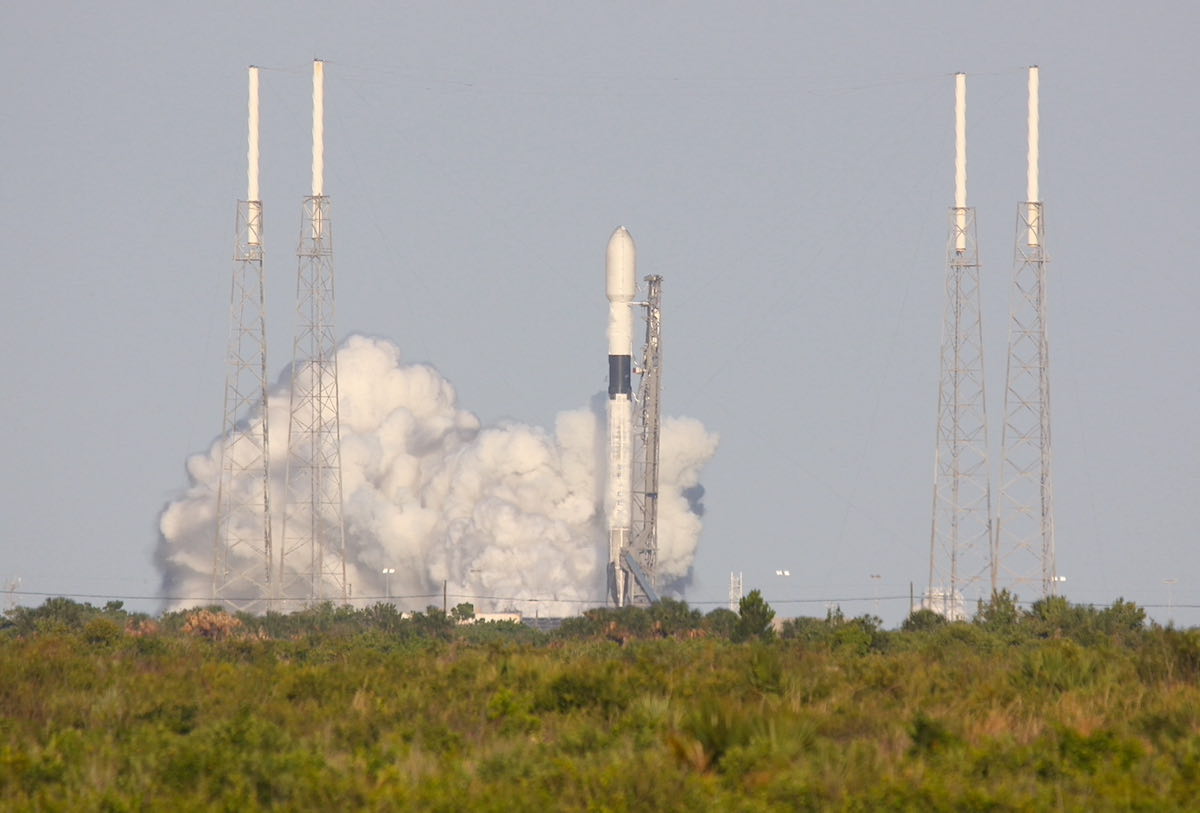SpaceX fired up a Falcon 9 rocket Monday on its launch pad at Cape Canaveral Space Force Station in Florida, running the launcher through a pre-flight checkout and clearing a hurdle before liftoff later this week with the next batch of Starlink internet satellites.
The 229-foot-tall (70-meter) rocket ignited its nine Merlin 1D main engines at 7:05 p.m. EDT (2305 GMT) Monday on pad 40 at Cape Canaveral. The engines appeared to run for several seconds, generating a cloud of exhaust that billowed out of the flame trench at the seaside launch complex.
Hold-down clamps kept the 1.2-million-pound rocket firmly on the ground throughout the firing, a once-customary checkout before every Falcon 9 launch.
SpaceX has skipped the static fire test before more than half of its Falcon 9 missions this year. The test-firing was a standard part of all SpaceX missions for most of the company’s history. But before Monday’s static fire, only five of the 15 Falcon 9 launches so far this year included pre-launch test-firings.
The company has countered the reduction in static fire tests with a more rapid launch cadence. Wednesday’s mission will be the 16th Falcon 9 launch since Jan. 1, the fastest start to any year by a U.S. orbital-class rocket. Cutting out the static fire can cut the time between launches from the same pad by up to a few days.
SpaceX’s launch team loaded the Falcon 9 with super-chilled, densified kerosene and liquid oxygen propellants beginning about 35 minutes before the test-firing Monday evening. With the static fire test complete, SpaceX engineers planned to drain the propellant tanks and assess data from the rocket to ensure all systems are in good shape for launch.

If everything checks out OK, SpaceX will give the go-ahead to continue preparations for liftoff at 2:59 p.m. EDT (1859 GMT) Wednesday with the next batch of approximately 60 satellites for the company’s Starlink internet network.
There is a 90% chance of acceptable weather for liftoff of the Falcon 9 rocket Wednesday afternoon, with mostly sunny skies, warm temperatures, and favorable winds expected, according to a forecast issued by the U.S. Space Force’s 45th Weather Squadron at Patrick Space Force Base. There’s only a slight chance of a cumulus cloud moving into the flight path of the Falcon 9 rocket at launch time.
SpaceX plans to land the Falcon 9’s reusable booster on the football field-sized drone ship “Just Read the Instructions” positioned downrange in the Atlantic Ocean.
It will mark SpaceX’s sixth Falcon 9 launch in less than five weeks, a busy stretch that began with the April 23 liftoff of a Crew Dragon capsule carrying four astronauts on a six-month mission to the International Space Station.
Since then, SpaceX has launched four more Falcon 9 rockets, each carrying Starlink broadband satellites. The company’s most recent mission, on May 15, carried 52 Starlink spacecraft and two rideshare payloads for the radar remote sensing company Capella Space and the small satellite manufacturer Tyvak.
The Falcon 9 launch Wednesday — the 119th Falcon 9 flight since the vehicle’s debut in 2010 — will follow a similar trajectory as other recent Starlink launches. The rocket will arc northeast from Florida’s Space Coast and release the 60 Starlink satellites into orbit about an hour after liftoff.
Once in orbit, the satellites will deploy solar panels and activate their ion thrusters to maneuver into an operational orbit 341 miles (550 kilometers) above Earth at an inclination of 53 degrees to the equator, where they will join the Starlink fleet beaming high-speed, low-latency internet signals to users around the world.
With the launch Wednesday, SpaceX will have put 1,737 Starlink internet satellites into orbit since May 2019, including prototypes and dead spacecraft no longer in service. This week’s flight will bring SpaceX’s active internet constellation to more than 1,600 spacecraft.
An analysis by Jonathan McDowell, an astronomer and respected tracker of spaceflight activity, suggests SpaceX has 1,574 working Starlink satellites in orbit as of Monday, with 933 operational spacecraft, plus hundreds more maneuvering to their final locations in the constellation.
The Starlink network is the largest satellite fleet in history, and SpaceX is adding more spacecraft to expand the constellation to provide global internet service. SpaceX, founded and led by billionaire Elon Musk, is currently providing interim internet services through the Starlink satellites to consumers who have signed up for a beta testing program in the United States, Canada, the United Kingdom, Germany, New Zealand, France, Austria, and the Netherlands.
SpaceX has regulatory approval from the Federal Communications Commission to eventually launch and operate up to 12,000 internet relay satellites.
Email the author.
Follow Stephen Clark on Twitter: @StephenClark1.
